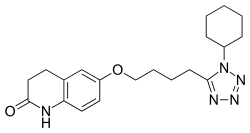Cilostazol
 | |
| Clinical data | |
|---|---|
| Pronunciation |
/sɪˈlɒstəzɒl/ sil-OS-tə-zol |
| Trade names | Pletaal |
| AHFS/Drugs.com | Monograph |
| MedlinePlus | a601038 |
| Pregnancy category |
|
| Routes of administration | By mouth (tablets) |
| ATC code | |
| Legal status | |
| Legal status | |
| Pharmacokinetic data | |
| Protein binding | 95–98% |
| Metabolism | Hepatic (CYP3A4- and CYP2C19-mediated) |
| Elimination half-life | 11–13 hours |
| Excretion | Renal |
| Identifiers | |
| |
| CAS Number | |
| PubChem CID | |
| IUPHAR/BPS | |
| DrugBank | |
| ChemSpider | |
| UNII | |
| KEGG | |
| ChEBI | |
| ChEMBL | |
| ECHA InfoCard |
100.215.897 |
| Chemical and physical data | |
| Formula | C20H27N5O2 |
| Molar mass | 369.46 g/mol |
| 3D model (JSmol) | |
| |
| |
| (verify) | |
Cilostazol is a quinolinone-derivative medication used in the alleviation of the symptoms of intermittent claudication in individuals with peripheral vascular disease. It is manufactured by Otsuka Pharmaceutical Co. under the trade name Pletaal.
Although drugs similar to cilostazol have increased the risk of death in patients with congestive heart failure, studies of significant size have not addressed people without the disease.
Cilostazol is a phosphodiesterase 3 inhibitor with therapeutic focus on cyclic adenosine monophosphate (cAMP). It inhibits platelet aggregation and widens arteries (direct arterial vasodilator). Its main effects are dilation of the arteries supplying blood to the legs and decreasing platelet coagulation.
Mechanism
Cilostazol is a selective inhibitor of phosphodiesterase type 3 (PDE3) with therapeutic focus on increasing cAMP. An increase in cAMP results in an increase in the active form of protein kinase A (PKA), which is directly related with an inhibition in platelet aggregation. PKA also prevents the activation of an enzyme (myosin light-chain kinase) that is important in the contraction of smooth muscle cells, thereby exerting its vasodilatory effect.
Clinical use
Cilostazol is approved for the treatment of intermittent claudication. The typical dose is 100 mg twice a day. The effects may take as long as 3 months to be evident and has been shown to improve pain-free walking distance by 50%.
Cilostazol is also frequently used off-label, at the same dose, for treatment of intracranial atherosclerosis and secondary stroke prevention.[1]
In people with heart failure
Cilostazol is dangerous for people with severe heart failure. Cilostazol has been studied in people without heart failure, without evidence of harm, but much more data would be needed to determine no risk exists. Although cilostazol would not be approvable for a trivial condition the Cardio-Renal Advisory Committee and FDA concluded that fully informed patients and physicians should be able to choose to use it to treat intermittent claudication. Patient and physician labeling will describe the basis for concern and the incomplete information available.[2]
Adverse effects
Possible side effects of cilostazol use include headache (the most common), diarrhea, severe heat intolerance, abnormal stools, increased heart rate, and palpitations.[3]
Interactions
Cilostazol is metabolized by CYP3A4 and CYP2C19, two isoenzymes of the cytochrome P450 system. Drugs that inhibit CYP3A4, such as itraconazole, erythromycin, ketoconazole, and diltiazem, are known to interact with cilostazol. The proton pump inhibitor omeprazole, a potent inhibitor of CYP2C19, increases exposure to the active metabolite of cilostazol.[3]
A single report has been made of grapefruit juice possibly increasing the effects of cilostazol;[4] some drug information sources list this as a possible interaction.[5][6][7] The FDA-approved labeling of cilostazol notes that grapefruit juice (which is a CYP3A4 inhibitor) increases the drug's maximum concentration by around 50%.[3]
See also
- Aripiprazole — an atypical antipsychotic with similar dihydroquinolinone core structure.
References
- ↑ Kwon, SU; Cho, YJ; Koo, JS; Bae, HJ; Lee, YS; Hong, KS; Lee, JH; Kim, JS (3 March 2005). "Cilostazol Prevents the Progression of the Symptomatic Intracranial Arterial Stenosis: The Multicenter Double-Blind Placebo-Controlled Trial of Cilostazol in Symptomatic Intracranial Arterial Stenosis" (PDF). Stroke. 36 (4): 782–6. doi:10.1161/01.STR.0000157667.06542.b7. PMID 15746463. Retrieved 27 December 2016.
- ↑ Center for Drug Evaluation and Research (August 11, 1999). "Approval of Cilostazol". U.S. Food and Drug Administration. Archived from the original on 2007-04-27. Retrieved 2007-04-30.
- 1 2 3 "Cilostazol: Official FDA information, side effects and uses". Drugs.com. February 2008. Retrieved 2008-09-22.
- ↑ Taniguchi, K; Ohtani, H; Ikemoto, T; Miki, A; Hori, S; Sawada, Y (October 2007). "Possible Case of Potentiation of the Antiplatelet Effect of Cilostazol by Grapefruit Juice". Journal of Clinical Pharmacy and Therapeutics. 32 (5): 457–9. doi:10.1111/j.1365-2710.2007.00844.x. PMID 17875111.
- ↑ "Cilostazol for peripheral arterial disease". Yahoo! Health. Retrieved 2008-09-21.
- ↑ "Cilostazol". MedicineNet.com. May 25, 1999. Retrieved 2008-09-22.
- ↑ Cerner-Multum, Inc. (November 29, 2007). "Consumer Drug Information: Cilostazol". Drugs.com. Retrieved 2008-09-22.